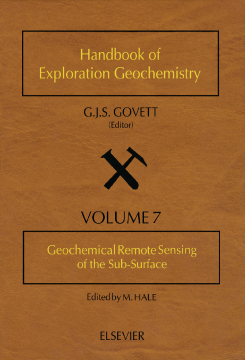
Additional Information
Book Details
Abstract
This volume documents the techniques for geochemical remote sensing of the subsurface, to present case-history evidence of their successes and limitations, and to consider their further potential. The chapters in Part I focus on the mechanisms and models of dispersion that give rise to the patterns we attempt to detect. Part II deals with the detection of dispersion patterns that owe their origins to processes, such as leakage, that are allied to resource emplacement. Part III describes the detection of dispersion patterns that are generated by processes, such as radiodecay and oxidation, taking place in deposits after their emplacement.
Every chapter brings a fresh perspective. Radon has met with much success in uranium exploration, whilst thorough research studies on helium and mercury lead to conclusions that tend to discourage use of these gases in mineral exploration. The case for light hydrocarbons is one of compelling simplicity whilst elaborate mathematical and electrochemical models are advanced for metal migration.
(B. Foster)
The volume is well-written and well-illustrated and is a tribute to the Editor (...) The reviews of geochemical principles, collection and analytical techniques, and critical appraisals of case histories make this an extremely valuable volume. (...) I found the book stimulating, challenging, and extremely informative and have no hesitation in stating that it merits the attention of everyone involved in geochemical exploration and research.
International Liaison Group on Gold Mineralization Newsletter, No. 30
(Australian Mineral Foundation)
This book is of real value to the company exploration geologist just as much as to the researcher and academic. The forty pages of references alone make it a first-stop for anyone seeking to use vapour geochemistry.
AMF Alert, 2/4
(D.L. Kelley, WMC Exploration, Denver, CO, USA)
It's clear that many of the authors will benefit from reading the papers from their co-contributors. This, in and of itself, is one of the significant contributions of the book to the exploration community. It brings together a wealth of research from a diverse group of scientists working in both petroleum and minerals exploration. Interactions between these two exploration industries, perhaps facilitated by this book, may lead to further breakthroughs in our understanding of these complex processes.(...)it is recommended for explorationists and researchers in the minerals and petroleum industries.
Mineralium Deposita Vol. 36, No.2
(F. Michael, Geoscience Consultant, Houston, TX, USA)
The illustrations and equations are well presented and explained throughout the book. About 30 pages of references are given at the end in case more details are needed. The book emphasizes these new approaches of geochemical remote sensing and is a must read for any person involved in petroleum or mineral exploration.
AAPG Bulletin Vol. 85, No. 7
